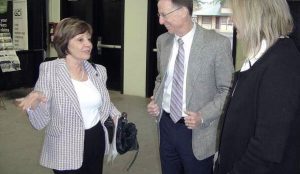
Secretary Ross in Orland before the second annual North State Innovation Conference, speaking with Glenn County Fair CEO Ryann Newman (r) and Kevin Spafford of Ryan Wealth Management. Photo by Tim Hearden, Capital Press
By Tim Hearden
ORLAND, Calif. — State Food and Agriculture Secretary Karen Ross held up the rice industry in the middle Sacramento Valley as an example of how growers can respond to public concerns about their production activities.
The industry’s effort about a decade ago to move away from winter residue burning by using water for decomposition quieted downwind complaints from urban residents while creating habitat for birds — and enhancing an already famous hunting ground, Ross said.
The move illustrates what California’s 77,500 farms often have to do to mollify concerns among the state’s roughly 40 million residents, many of whom may have formed misconceptions based on inaccurate information, she said.
“People don’t know how passionate we are about our land and all the steps we take to preserve it,” Ross told about 75 people at the second annual North State Innovations in Agriculture conference Nov. 8 at the Glenn County Fairgrounds.
She urged growers to work with environmental groups and cultivate relationships and human interactions with city dwellers and consumers.
“You have the water of the state, and you have the wildlife, the forests and the diverse landscapes,” Ross said. “If you want to be bolder going forward, you have to form partnerships and communicate with more people.”
Ross’ remarks came during a wide-ranging speech and question-and-answer session near the close of the conference, which was started to educate Northern California farmers and ranchers about technological advances and marketing trends.
Her message provided a bookend after keynote speaker David Schabazian, a manager for the Sacramento Area Council of Governments, opened the conference Nov. 7 by telling growers they should form partnerships with local government planners to have input on land-use policies that could maximize their farms’ earning potential.
Noting the conference’s focus on emerging technologies, Ross cautioned producers not to lose their human touch. She encouraged farmers to tell their stories on social media and in personal interactions with consumers.
“People can feel a connection with you even if they’ve never met you,” she said.
She pointed to former California Cattlemen’s Association president Matt Byrne, whose family’s SunFed Ranch markets its new grass-fed beef product lines by handing out samples at functions such as last year’s Natural Products Expo West in Anaheim, Calif.
“That takes a lot of effort,” Ross said, adding the ranch doesn’t sell all of its beef that way but still finds the venues valuable.
While California’s regulations often flummox growers, the upside is that the state’s products are coveted around the world because people know they’ve met high standards, she said. To that end, California Grown, an organization that promotes the state’s farm products, is working with the group Visit California to enhance food- and beverage-related tourism, which already accounts for 25 percent of all the tourism to the Golden State, she said.


